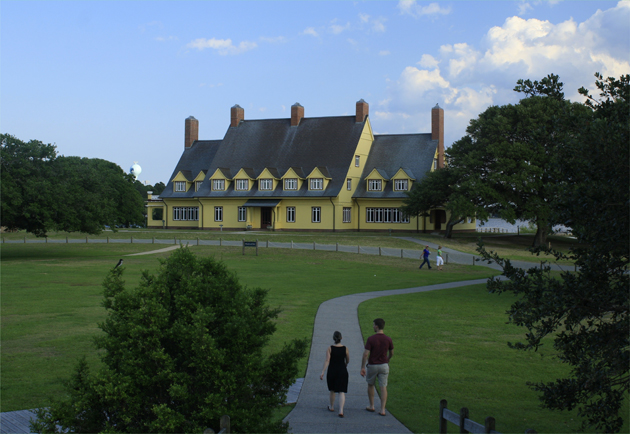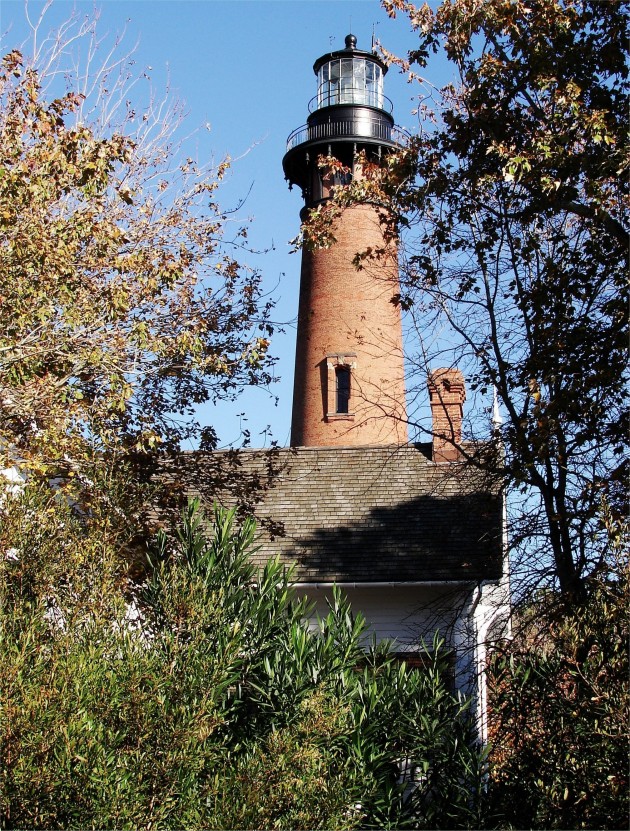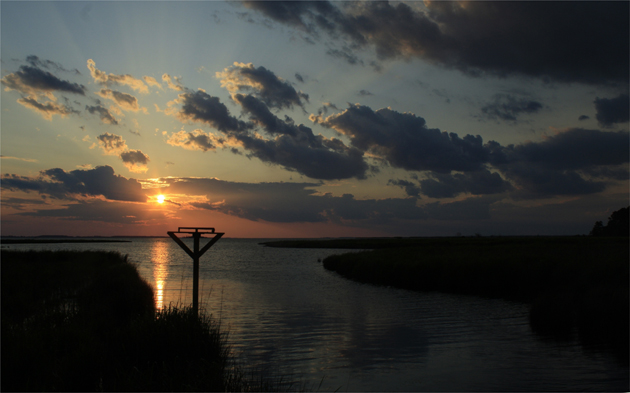Publisher's note: We believe the subject of history makes people (i.e., American people) smarter, so in our quest to educate others, we will provide excerpts from the North Carolina History Project, an online publication of the John Locke Foundation. This thirty-first installment, by Jonathan Martin, is provided courtesy of the North Carolina History Project.
A coastal county, Currituck was established in 1668 as one of the first colonial ports to North Carolina. Resting at the northern tip of the Outer Banks, Currituck County is surrounded by the Currituck Sound, Albermarle Sound, and the Atlantic Ocean. "Currituck" is an Indian term which means, "land of the wild geese", and the term serves its purpose because several wildlife refuges exist throughout the county, including the Currituck National Wildlife Refuge.
 Here upon the campus of the Whalehead Club one never loses sight of the towering Courrituck Beach Lighthouse, standing 163' high. The building along the water's edge, in the foreground, is the Outer Banks Learning Center, administered by the North Carolina Wildlife Commission, housing a retrospect of the life of the Currituck Sound watermen, and the wild geese that subsidized their way of life: Above. From the water another view of the Whalehead Club: Below. photos by Stan Deatherage Click the picture to expand to as much as 1000 pixels wide within most expanded images, and then push the arrows embedded in the center edge of the play-box to access the gallery, and slide new images into viewing within the center of the screen.
Here upon the campus of the Whalehead Club one never loses sight of the towering Courrituck Beach Lighthouse, standing 163' high. The building along the water's edge, in the foreground, is the Outer Banks Learning Center, administered by the North Carolina Wildlife Commission, housing a retrospect of the life of the Currituck Sound watermen, and the wild geese that subsidized their way of life: Above. From the water another view of the Whalehead Club: Below. photos by Stan Deatherage Click the picture to expand to as much as 1000 pixels wide within most expanded images, and then push the arrows embedded in the center edge of the play-box to access the gallery, and slide new images into viewing within the center of the screen.

The native Yeopim and Pasquotank were the first Native Americans to live in this Outer Banks region. The natives moved to the east as European settlers, the English and French Huguenots, started to immigrate to present-day Currituck County. Settlers established several fishing communities in Currituck, and by the year of the Revolution, the county had both a courthouse and a jail. Currituck's greatest landmarks remain these original structures.
 The home place of the Whalehead Club: Above and Below. photos by Stan Deatherage Click the picture to expand to as much as 1000 pixels wide within most expanded images, and then push the arrows embedded in the center edge of the play-box to access the gallery, and slide new images into viewing within the center of the screen.
The home place of the Whalehead Club: Above and Below. photos by Stan Deatherage Click the picture to expand to as much as 1000 pixels wide within most expanded images, and then push the arrows embedded in the center edge of the play-box to access the gallery, and slide new images into viewing within the center of the screen.

During the late nineteenth century, sportsmen and other outdoor enthusiasts toured Currituck, and it soon became a hunting and fishing oasis to the wealthy families in the Eastern United States. Several hunt clubs remain from this era including the Pine Island Club, the Currituck Shooting Club, and the Whalehead Club. The "Crown Jewel of the Outer Banks," the Whalehead Club, an exquisite residence constructed in 1925, remains an important tourist attraction in the county.
Some important landmarks and historical sites in Currituck include the Currituck Beach Lighthouse and the Haywood Bell House. At 163 feet tall, the Currituck Lighthouse started shining its light in the mid-nineteenth century. The lighthouse served as a warning light to incoming ships that sailed on the mythic "Graveyard of the Atlantic." An important cultural venue in Currituck is the Currituck County Library. In addition, the Currituck Heritage Park located in Corolla encompasses the Whalehead Club and the Outer Banks Center for Wildlife Education.
 The Courrituck Beach Lighthouse in late November: Above. The sunset over the Currituck Sound near the lighthouse in early June: Below. photos by Stan Deatherage Click the picture to expand to as much as 1000 pixels wide within most expanded images, and then push the arrows embedded in the center edge of the play-box to access the gallery, and slide new images into viewing within the center of the screen.
The Courrituck Beach Lighthouse in late November: Above. The sunset over the Currituck Sound near the lighthouse in early June: Below. photos by Stan Deatherage Click the picture to expand to as much as 1000 pixels wide within most expanded images, and then push the arrows embedded in the center edge of the play-box to access the gallery, and slide new images into viewing within the center of the screen.

Currituck's seat of government is the town of Currituck, and although it has never been officially incorporated, town records reveal that the town formed in the mid-eighteenth century. Coinjock, Corolla, Sligo, Tulls Creek, and Knotts Island are other communities and towns within Currituck County. These communities host several festivals and events annually, and they include the Currituck County Resource Fair, the Corolla Seafood Festival, and the Currituck Wildlife Festival.
Thomas J. Jarvis (1836-1915) remains an important native son of Currituck. Appointed to the governorship after Zebulon Vance left to serve in the U.S. Senate, Governor Jarvis incorporated several policies to support North Carolina farmers, grow N.C. education and to eliminate state government waste. In 1885, Jarvis accepted the position as U.S. Minister to Brazil. Although he declined the chance to be the law school dean at Trinity College (present-day Duke University) and the opportunity to be North Carolina State's first president, Jarvis helped establish East Carolina University by advocating for teacher's training school in Greenville.
 On this groun, between these dunes, is where the wild ponies and horses run unabated: Above and Below. photos by Stan Deatherage Click the picture to expand to as much as 1000 pixels wide within most expanded images, and then push the arrows embedded in the center edge of the play-box to access the gallery, and slide new images into viewing within the center of the screen.
On this groun, between these dunes, is where the wild ponies and horses run unabated: Above and Below. photos by Stan Deatherage Click the picture to expand to as much as 1000 pixels wide within most expanded images, and then push the arrows embedded in the center edge of the play-box to access the gallery, and slide new images into viewing within the center of the screen.

An interesting trait of Currituck County includes its distinction as home to the largest population of "Banker" ponies. The Banker Ponies are descendants of Spanish mustangs, which are believed by some historians to have come from a Spanish expedition in the 1500s. However, others estimate that the original Banker breed can be traced back to the Lost Colony or Ponce de Leon. Yet, it is unclear where exactly the horses stem from because they have existed on the Outer Banks for several centuries.
Sources:
"Currituck County; Wild Horses." William S. Powell, ed. Encyclopedia of North Carolina (University of North Carolina Press: Chapel Hill, NC 2006).
"History of Currituck County." Currituck County government website. www.co.currituck.nc.us/History.cfm, (accessed November 18, 2011).
"Thomas Jarvis." North Carolina Highway Historical Marker Program website. A Division of the North Carolina Department of Cultural Resources. (accessed November 18, 2011).






























